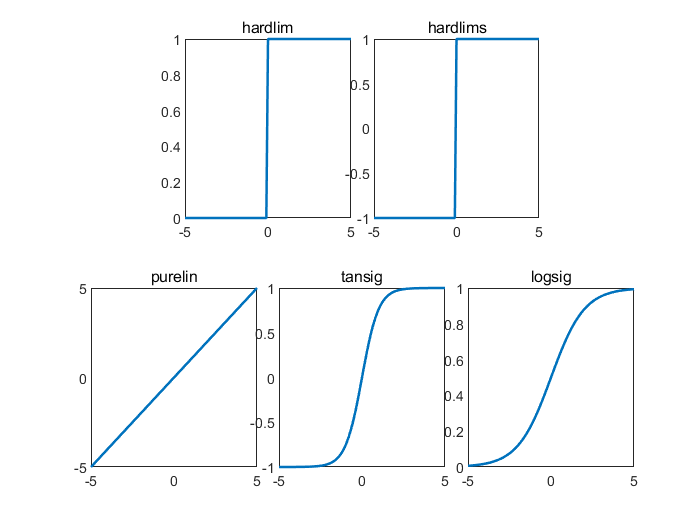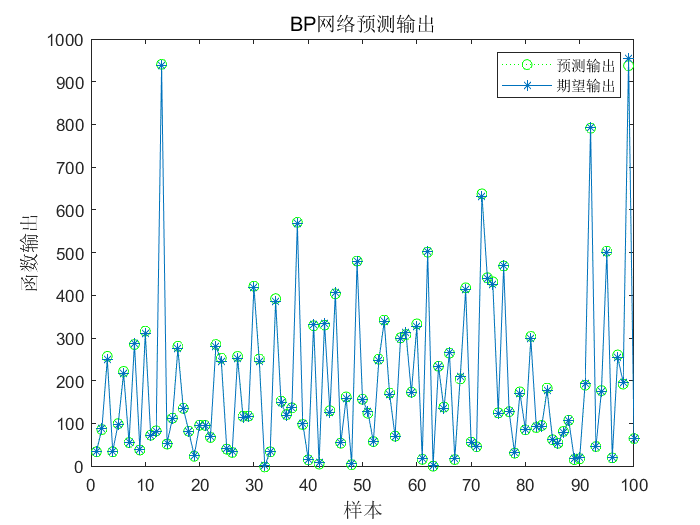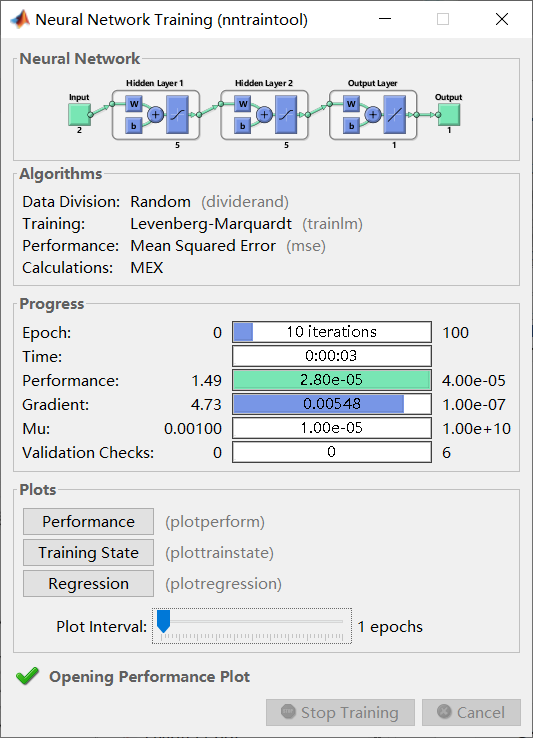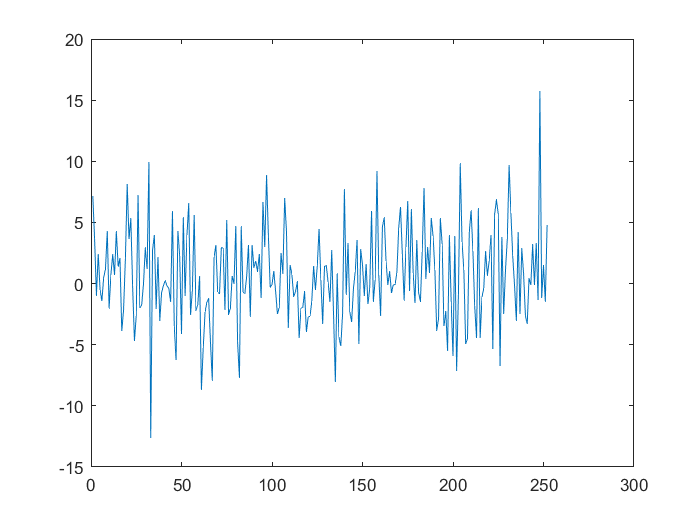2.1 案例背景
在工程应用中经常会遇到一些复杂的非线性系统,这些系统状态方程复杂,难以用数学方法准确建模。在这种情况下,可以建立BP神经网络表达这些非线性系统。该方法把未知系统看成是一个黑箱,首先用系统输入输出数据训练BP神经网络,使网络能够表达该未知函数,然后用训练好的BP神经网络预测系统输出。
本章拟合的非线性函数为[y = {x_1}^2 + {x_2}^2]该函数的图形如下图所示。
t=-5:0.1:5;
[x1,x2] =meshgrid(t);
y=x1.^2+x2.^2;
surfc(x1,x2,y);
shading interp
xlabel('x1');
ylabel('x2');
zlabel('y');
title('非线性函数');

2.2 模型建立
神经网络结构:2-5-1
从非线性函数中随机得到2000组输入输出数据,从中随机选择1900 组作为训练数据,用于网络训练,100组作为测试数据,用于测试网络的拟合性能。
2.3 MATLAB实现
2.3.1 BP神经网络工具箱函数
newff
BP神经网络参数设置函数。
net=newff(P, T, S, TF, BTF, BLF, PF, IPF, OPF, DDF)
- P:输入数据矩阵;
- T:输出数据矩阵;
- S:隐含层节点数;
- TF:结点传递函数。包括硬限幅传递函数hardlim、对称硬限幅传递函数hardlims、线性传递函数purelin、正切 型传递函数tansig、对数型传递函数logsig;
x=-5:0.1:5;
subplot(2,6,[2,3]);
y=hardlim(x);
plot(x,y,'LineWidth',1.5);
title('hardlim');
subplot(2,6,[4,5]);
y=hardlims(x);
plot(x,y,'LineWidth',1.5);
title('hardlims');
subplot(2,6,[7,8]);
y=purelin(x);
plot(x,y,'LineWidth',1.5);
title('purelin');
subplot(2,6,[9,10]);
y=tansig(x);
plot(x,y,'LineWidth',1.5);
title('tansig');
subplot(2,6,[11,12]);
y=logsig(x);
plot(x,y,'LineWidth',1.5);
title('logsig');

- BTF:训练函数。包括梯度下降BP算法训练函数traingd、动量反传的梯度下降BP算法训练函数traingdm、动态自适应学习率的梯度下降BP算法训练函数traingda、动量反传和动态自适应学习率的梯度下降BP算法训练函数traingdx、Levenberg_Marquardt的BP算法训练函数trainlm;
- BLF:网络学习函数。包括BP学习规则learngd、带动量项的BP学习规则learngdm;
- PF:性能分析函数,包括均值绝对误差性能分析函数mae、均方差性能分析函数mse;
- IPF:输入处理函数;
- OPF:输出处理函数;
- DDF:验证数据划分函数。
一般在使用过程中设置前面6个参数,后面4个参数采用系统默认参数。
train
用训练数据训练BP神经网络。
[net, tr]=train(NET, X, T, Pi, Ai)
- NET:待训练网络;
- X:输入数据矩阵;
- T输出数据矩阵;
- Pi:初始化输入层条件;
- Ai:初始化输出层条件;
- net:训练好的网络;
- 训练过程记录。
sim
BP神经网络预测函数。
y=sim(net, x)
- net:训练好的网络;
- x:输入数据;
- y:网络预测数据。
2.3.2 数据选择和归一化
%% 基于BP神经网络的预测算法 %% 清空环境变量 clc clear %% 训练数据预测数据提取及归一化 input=10*randn(2,2000); output=sum(input.*input); %从1到2000间随机排序 k=rand(1,2000); [m,n]=sort(k); %找出训练数据和预测数据 input_train=input(:,n(1:1900)); output_train=output(n(1:1900)); input_test=input(:,n(1901:2000)); output_test=output(n(1901:2000)); %选连样本输入输出数据归一化 [inputn,inputps]=mapminmax(input_train); [outputn,outputps]=mapminmax(output_train);
2.3.3 BP神经网络训练
%% BP网络训练 % %初始化网络结构 net=newff(inputn,outputn,5); % 配置网络参数(迭代次数,学习率,目标) net.trainParam.epochs=100; net.trainParam.lr=0.1; net.trainParam.goal=0.00004; %网络训练 net=train(net,inputn,outputn);
2.3.4 BP神经网络预测
%% BP网络预测
%预测数据归一化
inputn_test=mapminmax('apply',input_test,inputps);
%网络预测输出
an=sim(net,inputn_test);
%网络输出反归一化
BPoutput=mapminmax('reverse',an,outputps);
2.3.5 结果分析
%% 结果分析
figure(1)
plot(BPoutput,':og')
hold on
plot(output_test,'-*');
legend('预测输出','期望输出')
title('BP网络预测输出','fontsize',12)
ylabel('函数输出','fontsize',12)
xlabel('样本','fontsize',12)

%预测误差
error=BPoutput-output_test;
figure(2)
plot(error,'-*')
title('BP网络预测误差','fontsize',12)
ylabel('误差','fontsize',12)
xlabel('样本','fontsize',12)

figure(3)
plot((BPoutput-output_test)./output_test,'-*');
title('神经网络预测误差百分比')

% 计算平均绝对百分比误差(mean absolute percentage error) MAPE=mean(abs(BPoutput-output_test)./output_test)
![]()
2.4 扩展
2.4.1 多隐含层BP神经网络
net=newff(P, T, S, TF, BTF, BLF, PF, IPF, OPF, DDF)
S可为向量,如[5,5]表示该BP神经网络为双层,每个隐含层的节点数都是5。

- Neural Network:神经网络结构,输入、中间层、输出维度。
- Data Division:数据划分算法;
- Training:训练算法;
- Performance:误差算法;
- Calculations:编译算法。
- Epoch:迭代次数;
- Time:训练时间;
- Performance:误差;
- Gradient:梯度;
- Mu:阻尼因子;
- Validation Checks:泛化能力检查。
- Performance:误差图示;
- Training State:训练状况图示;
- Regression:回归曲线图示;
- Plot Interval:绘图刻度。
2.4.2 隐含层节点数
对复杂问题来说,网络预测误差随节点数增加一般呈现先减少后增加的趋势。
2.4.3 训练数据对预测精度的影响
缺乏训练数据可能使BP神经网络得不到充分训练,预测值和期望值之间误差较大。
2.4.4 节点转移函数
一般隐含层选择logsig或tansig,输出层选择tansig或purelin。
2.4.5 网络拟合的局限性
BP神经网络虽然具有较好的拟合能力,但其拟合能力不是绝对的,对于一些复杂系统,BP 神经网络预测结果会存在较大误差。
2.5 MATLAB doc
Feedforward networks consist of a series of layers. The first layer has a connection from the network input. Each subsequent layer has a connection from the previous layer. The final layer produces the network’s output.
Feedforward networks can be used for any kind of input to output mapping. A feedforward network with one hidden layer and enough neurons in the hidden layers, can fit any finite input-output mapping problem.
- feedforwardnet(hiddenSizes,trainFcn)
This following example loads a dataset that maps anatomical measurements x to body fat percentages t. A feedforward network with 10 neurons is created and trained on that data, then simulated.
[x,t] = bodyfat_dataset; net = feedforwardnet([10,10]); view(net); net = train(net,x,t); y = net(x); plot((y-t))

